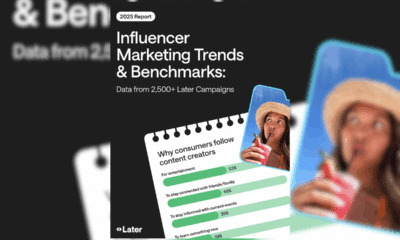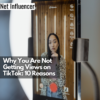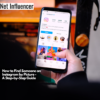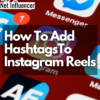Agency
XOMAD’s Rob Perry On Leveraging Data Intelligence To Maximize Influencer Marketing Impact
XOMAD’s technology processes more than 65 million influencer profiles to deploy armies of thousands of nano-creators, transforming influencer marketing from a supplementary tactic into a central strategy with measurable results. The Manhattan Beach-based company, with 64 employees—two-thirds of whom are engineers and data scientists—operates in an area where traditional digital marketing effectiveness has declined, while demand for genuine content has increased.
“The critical importance of scale in influencer marketing was never big enough in the early days,” says Rob Perry, founder and CEO of XOMAD. “It’s only in the last couple of years that we’ve started to do the right amount of scale, and the critical importance of scale is about the critical importance of frequency.”
Founded in 2010 as one of the first dedicated influencer marketing companies, XOMAD emerged from Rob’s observation that local trusted voices drive consumer behavior more effectively than traditional advertising. The company initially served brands like BlackBerry and Unilever before expanding to government agencies and non-profits seeking to reach communities resistant to conventional messaging.
Rob’s insights into influencer marketing originated decades before social media existed. In the early 1990s, he worked as a sports agent, representing basketball superstars such as Michael Jordan.
The Scale and Frequency Breakthrough
XOMAD’s core value proposition centers on a key insight about frequency—the number of times a consumer sees content from different trusted sources. Through years of campaign data, Rob’s team discovered that traditional influencer marketing campaigns weren’t deploying enough nano- and micro-creators to achieve the necessary frequency for maximum impact.
“Every marketeer can tell you the importance of frequency,” Rob explains, “but it’s so much more powerful in the influencer space because it’s not about seeing that same truck ad four times on TV. It’s about seeing content from at least four different people whom you trust and follow.”
XOMAD’s research revealed that when target audiences see content from between 4 and 8 different trusted messengers, campaigns deliver significantly higher results than those with lower frequency. This insight transformed their approach, leading them to deploy much larger groups of influencers for national campaigns.
“When we see the content at one, two, or three times, we don’t see the same efficacy as we do when it gets between 4 and 8,” Rob notes. This means XOMAD campaigns typically involve hundreds, sometimes thousands, of creators to reach the necessary frequency threshold.
Evidence for this approach appears in their public sector work, where Rob points to a clear correlation between higher frequency and better outcomes: “In the state of New Mexico, the counties that had higher frequency—meaning the target citizens there saw more content from more people they trust and follow—had the higher Medicaid re-enrollment rate.”
Technology That Enables Mass Deployment
To manage campaigns at this scale, XOMAD has invested heavily in proprietary technology. Their AI-powered platform enables them to search, vet, and coordinate massive networks of creators while maintaining quality and brand safety.
“We were using AI before it was trendy,” Rob says, describing their systems that analyze tens of millions of creators and their audiences. The vetting process begins with their database of more than 65 million U.S. creators, which their technology filters based on content quality, engagement rates, audience demographics, and target audience overlap.
According to XOMAD’s “Driving Action through Digital Communities” report, which shares a hypothetical influencer identification example, their AI engine can “crawl and analyze 9M+ profiles based on campaign requirements” and “crawl and analyze 27M+ pieces of content created by 510K creators to vet out irrelevant & inappropriate creators.” For each of the campaign candidates, XOMAD’s AI engine also analyzes audience demographics, quality, and uniquely, which of their audiences also follow other candidates. This massive Target Audience Overlap analysis capacity allows them to identify the ideal mix of messengers for each campaign who collectively maximize view frequency within specific target audiences.
The technology doesn’t replace human judgment, however. “Human beings are still the best at content analysis,” Rob acknowledges. “It is still an important layer that, at some point, our actual influencer experts, many of whom are influencers themselves, need to evaluate the content.”
The Vaccination Case Study
One of XOMAD’s most compelling demonstrations of its approach came during the COVID-19 pandemic, when it worked with multiple state health departments on vaccination campaigns. The South Carolina campaign provides a clear view of attribution in marketing effectiveness.
“In South Carolina, arguably the most vaccine-hesitant state in the entire country, they hired us to get the word out about vaccinations,” Rob explains. Due to the controversial nature of the topic, XOMAD worked with creators who maintained political neutrality by framing their content around personal choice: “They’re saying, ‘Look, I celebrate personal choice. Be yourself, choose what you want. But here are the reasons why I chose to get vaccinated.'”
What made this campaign uniquely measurable was an accidental experiment in content timing. “The South Carolina Health Department didn’t want to release all the content. They held it back and did a careful review,” Rob explains. When they finally approved all the content simultaneously, “The vaccination shot up 400% over the next several days. So 400% higher than the highest vaccination rate they’d ever seen before.”
This dramatic spike, recorded on state health department dashboards, provided clear evidence of the campaign’s impact. “I feel like that case study should be on the front page of the Wall Street Journal,” Rob remarks. “It’s a very rare case study because they made us wait, and then they released all the content at once, so the dramatic efficacy is crystal clear.”
The campaign’s success earned XOMAD the “Ad Age Social Media Campaign of the Year” Gold medal for their health awards in 2023—one of five Ad Age awards the company has won in the past two years for their public sector work.
The Council: Infrastructure for Quick Deployment
Beyond their vetting technology, XOMAD has developed a proprietary digital infrastructure called “The Council” that houses pre-vetted, contracted creators ready for immediate activation. This platform enables quick response capabilities, always-on communication, and efficient coordination of large creator networks.
“The Council is a great way for the clients to be able to talk to the influencers individually or collectively, and for the influencers to talk to one another,” Rob explains. “Their creativity goes up through brainstorming and sharing content.” This infrastructure proved particularly valuable during urgent situations, such as when the Louisiana Department of Health needed to quickly distribute hurricane preparedness information through their influencer network.
The Council also facilitates what XOMAD calls “organic boosting”—having creators engage with each other’s content to increase reach organically. According to their report, this approach helps “overcome topical suppression by social media platforms” and “create viral, targeted conversation that reaches specific geographies and interest niches.”
From Celebrity Endorsements to Trusted Messengers
As XOMAD has refined their approach, they’ve also changed their terminology. While “influencer” remains the industry standard term, Rob acknowledges its limitations.
“The only problem with the word influencer is it brings up images of Kim, Kylie, and Kendall [Kardashian/Jenner],” he says, noting that the industry has steadily moved from celebrity macros to micros and now to nano-influencers and user-generated content creators.
To better reflect their focus on smaller, more genuine voices, XOMAD often uses terms like “trusted messengers” when describing their creator networks. “It conveys what we’re actually doing better, particularly when you’re deploying large-scale nano-armies and you’re reaching into local communities,” Rob explains.
The Antidote to Digital Marketing’s Decline
XOMAD positions their approach as the solution to a growing challenge in digital marketing effectiveness. “We’re living in a world where everybody’s recognizing there’s been a huge decline in the efficacy of digital marketing and digital media buys,” Rob observes.
This decline stems largely from increased data privacy restrictions and consumer preferences. “Consumers have overwhelmingly said, ‘I don’t want to be tracked,'” Rob notes. Traditional digital marketing relied heavily on tracking technologies, now being restricted by privacy regulations and platform changes.
In contrast, influencer marketing leverages organic connections between creators and their audiences—relationships built on trust rather than tracking. “We’re the rebellion against digital marketing,” Rob says. “We’re also the industry’s answer to the decline in the efficacy of every other media strategy, not just TV, but digital—none of it is working like it used to.”
XOMAD’s technologies and services position them as “the antidote to the declining efficacy of digital and social advertising,” according to their report, “enabling personalized, targeted influencer marketing at massive scale” without relying on the tracking mechanisms that power traditional digital advertising.
Ensuring Brand Safety at Scale
With campaigns often addressing sensitive topics, such as public health, XOMAD has developed processes to ensure the accuracy of information and maintain brand safety. In 15 years of operation, Rob emphasizes they’ve “never had an influencer go off the reservation.”
For particularly sensitive campaigns, additional safeguards are implemented. “We asked the influencers to all sign NDAs,” Rob explains. “Before an influencer is going to be allowed to release content, there’s a thorough review process.”
Their vetting technology examines not just audience metrics but also evaluates past content for appropriateness. According to their report, XOMAD’s process screens for creators who might have “posted inappropriate content” or “conducted themselves in a way that wouldn’t reflect well on the client agency.”
The Future of Creator-Led Media
Rob expects the creator economy to take an increasingly important role in marketing strategies. “I believe that the creator economy is going to have a dominant role in the future of marketing,” he predicts. “We’re still in the infancy of this, and it’s going to grow and grow.”
The industry veteran anticipates that technology will become even more crucial, with major marketing holding companies developing or acquiring established influencer platforms. This shift is already evident, with Publicis recently purchasing Captiv8 after acquiring Influential, signaling a race among traditional agencies to develop creator marketing capabilities.
“I think you’re going to see a lot more technology-fueled M&A activity over the next few years,” Rob says of these acquisitions. “Those of us in the industry who have a robust technology, which can allow this kind of scale, will become increasingly important.”
As traditional marketing continues to face challenges in terms of effectiveness and consumer trust, XOMAD’s approach of deploying large numbers of trusted voices at scale represents a shift in how brands communicate with their audiences.
“Influencer marketing evolved using handfuls of creators. It was an add-on,” Rob concludes. “Now, you’re going to see mass deployments start to take over.”





















